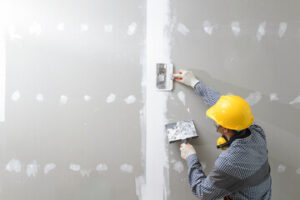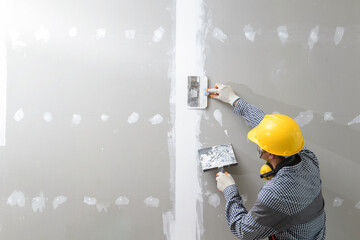Small holes, dents, and scrapes in drywall are fairly common. Sometimes, a little spackle and a quick smoothing will completely disappear the damage. However, cracks that extend past a few inches and discoloration can indicate larger problems with the structure of your home. It is important to address these issues before they worsen. Read on Drywall Repair Las Vegas to learn more.
 When repairing small holes in drywall, the best option is often spackle. This versatile, quick-drying material can fill holes in various surfaces, including drywall, plaster, and wood. It’s easy to apply, dries quickly, and can be sanded down and painted once fully dried. However, spackle isn’t designed for very large repairs and may not hold up well if the wall is subjected to movement or stress.
When repairing small holes in drywall, the best option is often spackle. This versatile, quick-drying material can fill holes in various surfaces, including drywall, plaster, and wood. It’s easy to apply, dries quickly, and can be sanded down and painted once fully dried. However, spackle isn’t designed for very large repairs and may not hold up well if the wall is subjected to movement or stress.
When spackling, it’s important to follow the instructions on the product packaging carefully. For example, many spackles require the user to sand down the repaired area once it’s dry in order to achieve a smooth finish. The sanding process can be time-consuming, but it’s essential to the success of the project.
It’s also important to choose the right spackle for your project. Some products are lighter and better suited for small repairs, while others are designed for larger repairs or for covering seams and joints. If you’re not sure which spackle to purchase, it’s a good idea to read reviews and product information in order to make an informed decision.
If you have a hole in your wall that’s bigger than a nail hole, or if the wall has been damaged by water (like a leaky faucet), you’ll need to use a more substantial repair material such as joint compound or mesh tape with reinforcing fabric. These materials are designed to be stronger and more durable than standard spackling, and they will hold up well when the surface is subjected to movement or stress.
To patch larger holes, the first step is to cut out the damaged portion of the drywall sheet. Once this is done, the remaining portion of the sheet should be smoothed using a putty knife and sanded down once it’s dry to ensure that the new patch is perfectly flush with the rest of the surface. Then, it’s a good idea to prime and paint the patched area so that it blends in seamlessly with the surrounding wall.
Patching Holes
One of the most noticeable effects on a wall is a hole where a screw, nail or pipe once stood. Patching these holes is relatively simple, and the results are a big improvement. But it’s important to note that before you cut away any drywall, check behind it for wires and pipes. If you don’t, you could damage them and incur expensive repairs.
To fix a small hole, simply use a drywall patch kit that includes a self-adhesive surface that sticks right to the wall. Before you apply the patch, however, sand the edges of the drywall and the surrounding wall to remove any ridges or bumps that might prevent the adhesive patch from sticking well.
If you’re repairing a large hole, you’ll need to add some support to the patch. Depending on the size of the hole, you can do this in one of several ways. One option is to build up the back of the drywall with plywood strips. This works especially well for larger holes because it prevents the patch from collapsing in on itself over time.
You can also build up the wall by adding small pieces of wood, called furring strips or backer boards, along the sides of the patch and securing them with screws. This is a particularly good method for large, rectangular holes because it helps to prevent the patch from bulging inward as it shrinks and sets up.
Another way to support a patch is by using what’s known as a California or butterfly patch. With this type of repair, you’ll start by cutting a piece of scrap drywall into a rectangle that’s a few inches bigger in both directions than the hole. On the back of the drywall, you’ll then score lines using a utility knife, but be sure not to cut through the front paper. When you’re done, you can snap the drywall along the scored lines to separate the back from the front.
Finally, you can reinforce a large hole by combining plywood strips and a butterfly patch. Before applying the patch, though, make sure to check for any wires that might run through the wall; if there are, you’ll need to leave them alone and work around them. Once the patch is in place, screw it securely to the supports and studs. When you’re finished, sand the surface smooth and touch it up with paint to blend the patch with the surrounding wall.
Drywall Repairs
Drywall repairs are a common part of any renovation or remodeling project, but these projects can be a bit complicated. If you aren’t comfortable with drywall repair or don’t have the time to do it yourself, it may be worth hiring a professional to get the job done right. The average cost of repairing drywall can vary depending on the size of the damage and other factors.
Small holes, cracks and dents can be repaired with spackle or a lightweight joint compound. These materials can be purchased at your local hardware store. You’ll also need a putty knife and sanding tool. For larger holes, you may need mesh drywall tape to help strengthen the joint compound or mud and to cover any uneven areas. Mesh tape is also helpful for long cracks and coin-sized holes, though these types of holes usually require a patch of drywall instead.
When you need to fix a large hole, start by cutting a piece of drywall to the same size as the damaged area. Make sure there aren’t any pipes or wires running through the wall before you cut it. Next, use a stud finder to locate the wall studs, where most electrical wires should be attached. Use the stud finder to mark a line at least an inch above and below the damaged area. Cut the board along this line to create two support boards for the patch.
Now you’re ready to apply your patch. Press the paper tape firmly into place and spread a thin coat of drywall compound over the top of it. Let the first coat dry, then add a second. When you’re done, sand the surface to smooth any ridges and blend edges. Finally, paint the patch to match the rest of the wall.
It’s a good idea to use a color that will hide any imperfections well. If you’re concerned about how to repair a damaged wall, shine a light across the area to see if there are any pock marks or high spots that need to be touched up.
It’s also important to keep in mind that a damaged wall can cause problems with the foundation of your home or building and lead to leaks, structural issues, mold and other serious concerns. If you find an extensive amount of drywall damage in your home, you should consider hiring a drywall contractor to repair it and ensure that the entire wall is safe for living and working.
Repairing Cracks
Drywall is a type of wall panel made from gypsum plaster sandwiched between two sheets of paper and commonly used in homes and buildings. Unlike painted wood, drywall is very durable, but over time it can develop cracks and holes. Fortunately, fixing these problems is relatively simple. For small scratches or dents less than 1/2 inch across, simply apply a thin layer of joint compound (also called drywall mud) using a 3- to 4-inch putty knife made for repairing drywall (rather than the kind of narrow utility knife you would use for wood putty) and smooth it till it’s flush with the wall. Larger gouges require reinforcing mesh before spackling.
If a hole is larger than 6 inches, you will need to install a new patch. A variety of drywall patch kits are available that contain a reinforced center panel surrounded by self-sticking tape. These are very easy to install and can be a good alternative to re-taping the crack.
Once the drywall patch is in place, use a hand or power sander to smooth it so it blends into the surrounding surface of the wall. This is especially important if you’re planning to re-paint the area later. A light-colored spackle or drywall compound will work best in hiding the repair.
The most common cause of drywall cracks is slight house “settling” that can usually be fixed by re-taping the seams where the drywall panels meet. However, cracks may also signal a more serious problem such as water leaks or structural problems and should be professionally inspected.
To fix a cracked drywall section, start by cutting away any protruding areas of the damaged wall. Next, scrape and cut any loose tape off the wall’s surface. Then cut a piece of drywall board 3 to 4 inches longer than the section you’re repairing. Screw the new drywall board to both the stud and the existing wall, making sure the edges are seated properly. Apply a thin coat of joint compound over the repaired section of the wall and let it dry as per the manufacturer’s instructions. When the first coat dries, apply second and third coats as needed to smooth the area. After the last coat of compound dries, sand the area with a fine-grit sanding sponge to get a crisp corner.
